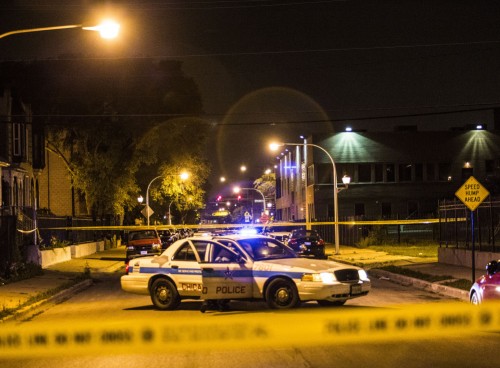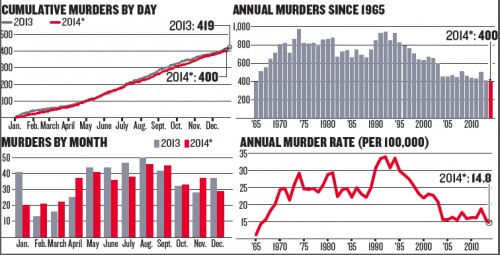
July 18 shooting in the 400 block of East 45th Place / Photo by Alex Wroblewski
BY MICHAEL LANSU
Homicide Watch Chicago Editor
Chicago could record its lowest murder total in nearly five decades for the second consecutive calendar year, despite an increase in shootings in 2014.
Chicago Police reported 390 murders through Dec. 20, while the Cook County medical examiner’s office reported 410 homicides, including 16 fatal police shootings, during the same period. There have been at least 10 additional homicides and one fatal police shooting since then.
Police, which follow federal guidelines when counting murders, determined some of the homicides were self-defense or accidents.
The numbers represent a 2 to 4 percent decrease in killings from 2013, and a 19 to 20 percent decrease from the unusually high 2012, when there were 504 murders. It would be fewest killings in any year since the 397 slayings in 1965.
While the citywide murder total remained nearly identical to last year, some communities saw higher totals.
“While the data shows Chicago has seen the fewest murders and lowest crime rate in decades, the ultimate measure of our success is how our residents feel in their communities,” Mayor Rahm Emanuel said.
On the Northwest Side, the Humboldt Park community went from 14 killings in 2013 to 25 through Thursday — the largest increase in the city.
Despite the jump, Ald. Walter Burnett (27th), whose ward includes a violent portion of Humboldt Park near Chicago Avenue, said he believes police programs are working, and the rise in murders was partially caused by a recent spike in gang activity.
“We have embedded crime in this area — we always have,” Burnett said. “[Police] were bringing it down earlier in the year, and then it started back again … I think having police walking around in these challenging areas, building relationships with the people in the neighborhood, will go a long way.”
Robert Tracy, Chicago Police chief of crime control strategies, confirmed that several gang conflicts led to increased violence and noted that the Harrison District, which includes the southwest portion of the Humboldt Park community, has the most “impact zones” in the city.
“Crime adjusts from our deployments and our strategies,” Tracy said of the area. “Are we in the right areas? Are we ahead of these gangs? We are trying to stay one step ahead, and we are trying to deploy in the right places and look at the right people. … We just have to see what we are missing, and we have to do better. We are doing evaluations on a daily basis.”
While some communities saw large increases in murders, others saw drastic declines.
The South Shore community went from 26 slayings in 2013 to 14 through Thursday of this year.
Tracy credited Grand Crossing District Cmdr. James E. Jones and other leaders for the turnaround in the South Shore area.
“If you don’t have the right people, you aren’t going to see the success,” Tracy said. “We put a plan in place, they executed them properly and we started seeing dramatic results.”
While many areas saw drastic changes in their murder totals, the Austin community, the most populous in the city, had only a slight increase but remained the community with the most slayings for a second consecutive year.
The Rev. Ira Acree, of Austin’s Greater St. John Bible Church, 1256 N. Waller, said he believes economic desperation has contributed to crime, and he called on elected officials to promote urban renewal in the community.
“We still have a lot of problems with unemployment and underemployment,” Acree said. “Economic desperation prompts people to resort to desperate measures … we are not savages over here.”
Emanuel says reducing crime involves more than just policing.
“We will continue building on our comprehensive policing and prevention efforts, and expanding on our partnership with community leaders, faith leaders, and residents to ensure everyone in every neighborhood in Chicago enjoys the same sense of safety,” Emanuel said. “Until we have achieved that important goal, our work together will not be complete.”

While the city’s overall murder total remained close to 2013, the same cannot be said about the number of people shot. More than 2,500 people were wounded by gunfire through Dec. 20 — a 13 percent increase from 2013. The total was, however, a 14 percent decrease from 2012.
On the Near West Side, Stroger Hospital, the state’s largest trauma center, treated more than 570 victims of gun violence in the first 11 months of 2014.
“We don’t see our patients as statistics. We treat every patient as an individual and take immense pride in the care we provide to victims of senseless gun violence,” said Dr. Faran Bokhari, chairman of the hospital’s Department of Trauma and Burn. “Our team and our survival rates are exceptional. We work closely with our patients during their medical and emotional recovery and have increased our efforts at prevention so that we may avoid the loss of life and the grave disability that shootings and other traumas confer.”
July had the most shooting incidents with 248 and the most shooting victims with 323. August had the most murders with 41.

July 11 shooting near Evergreen & Rockwell / Photo by Alex Wroblewski
In an effort to decrease crime, the city started or expanded several new policies in 2014, including boosting its custom notification program to make more personal visits to those involved in active gang conflicts, putting more officers on the street in high crime areas over the summer and investing in more bike patrol officers.
Despite the rise in shootings this year, Chicago is in line with the national Great Crime Decline that has spanned more than 20 years, Yale sociologist Andrew Papachristos said.
The city has gone from 943 murders in 1992 to 633 in 2000 to just over 400 in each of the past two years. Papachristos noted changes in policing, education and community organizations as some of the factors for the decline.
“Chicago is both unique and not all that special at the same time,” Papachristos said. “The whole country is experiencing the Great Crime Decline, and Chicago’s trend mirrors that. … Chicago has one of the largest murder totals, but rates are really important when comparing things of different sizes. Chicago is not more violent than other cities; it is New York that has experienced unusually large declines. We are comparable [in total number] to New Orleans, which has about 300,000 people.”